齐全2012广州版三年级英语下册期末总复习资料(包括单词,句型,语法)
文档属性
| 名称 | 齐全2012广州版三年级英语下册期末总复习资料(包括单词,句型,语法) | 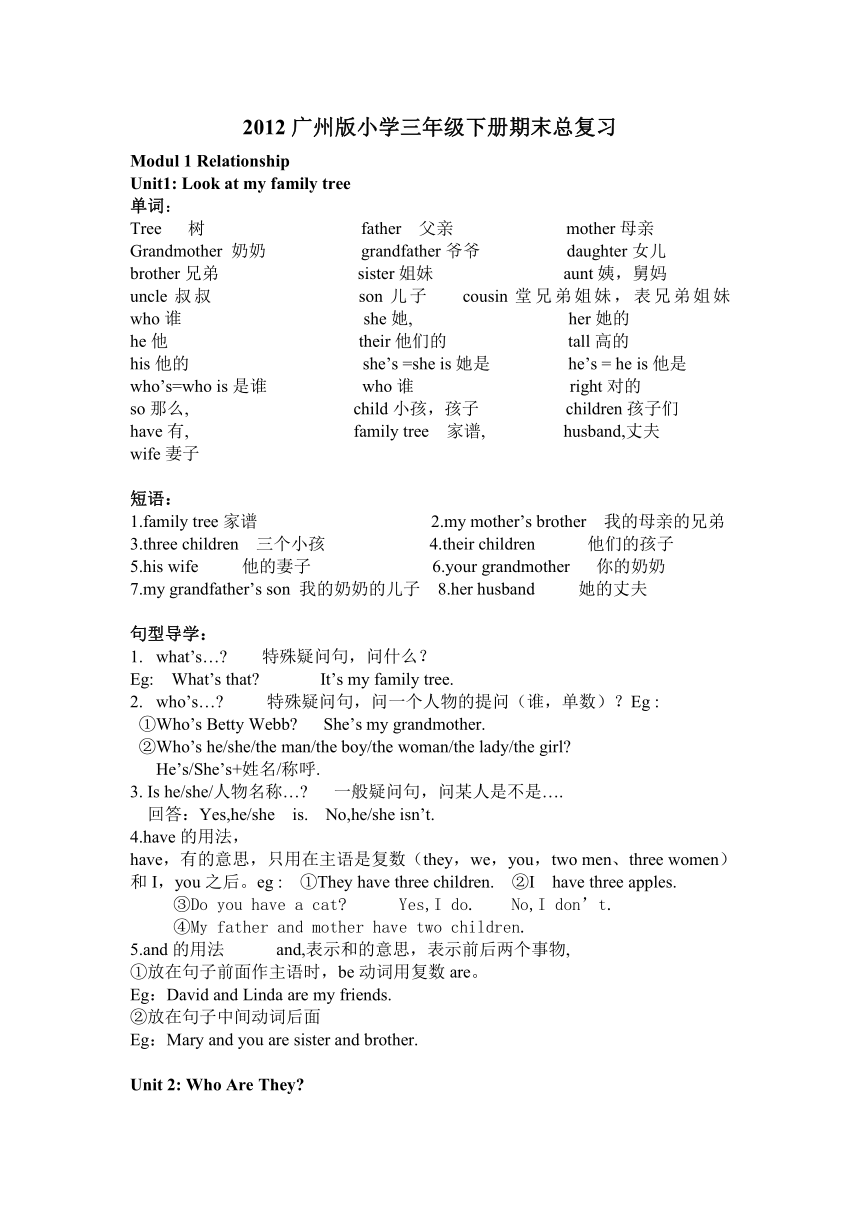 | |
| 格式 | zip | ||
| 文件大小 | 27.9KB | ||
| 资源类型 | 教案 | ||
| 版本资源 | 广州版 | ||
| 科目 | 英语 | ||
| 更新时间 | 2012-07-24 17:50:01 | ||
图片预览

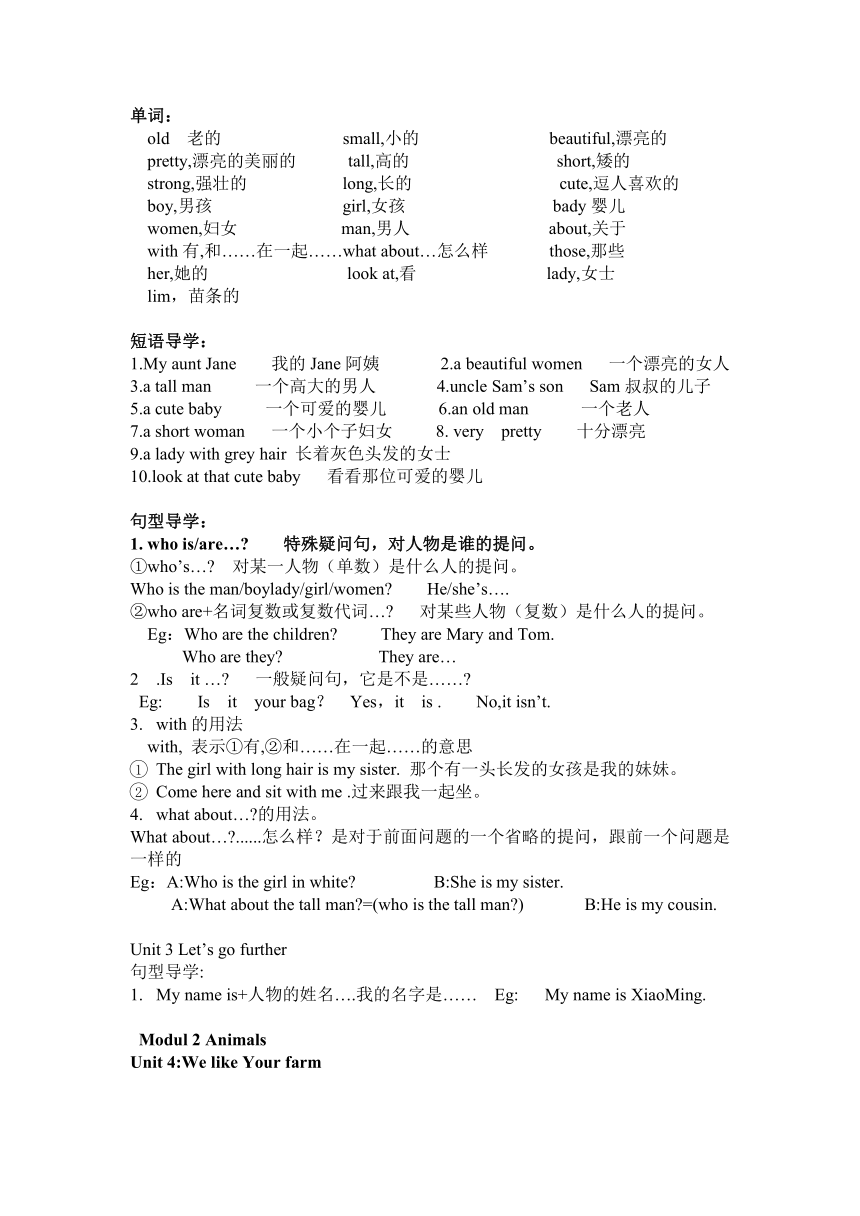
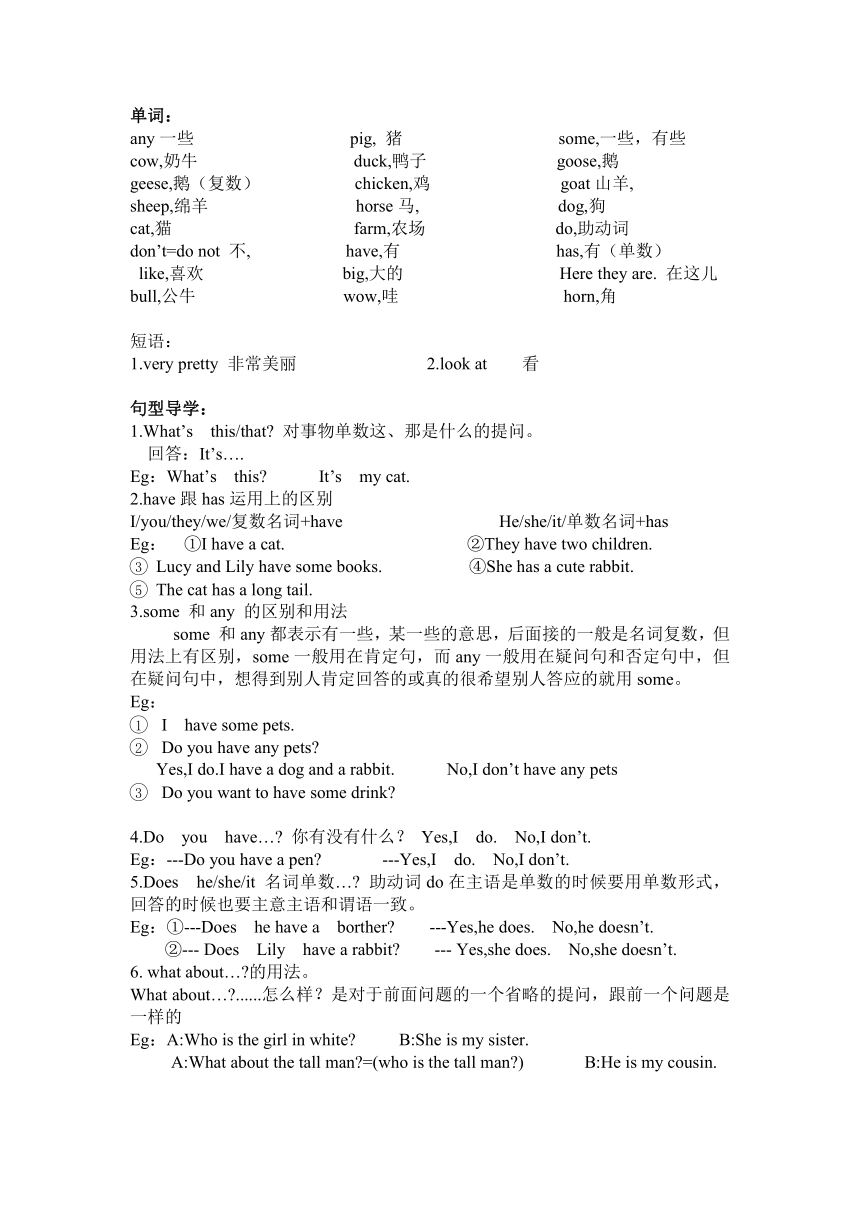
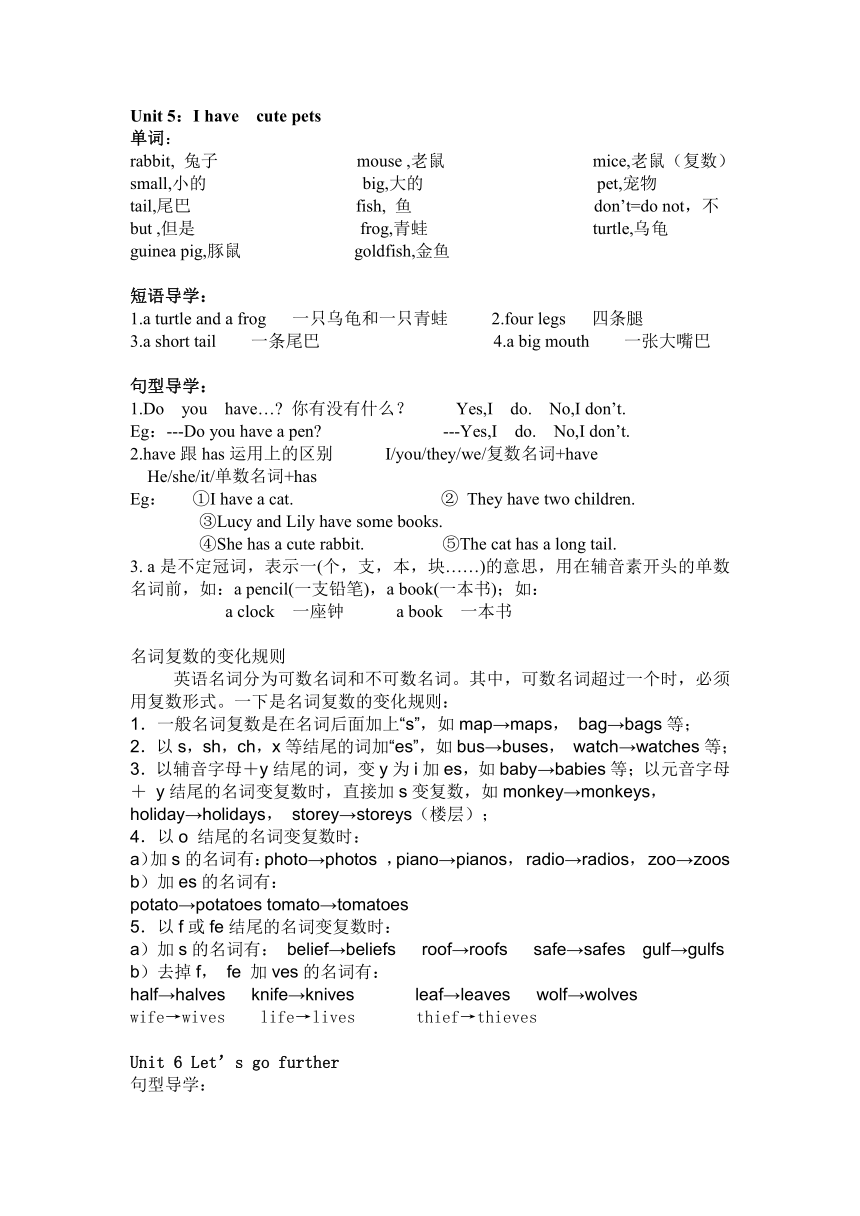
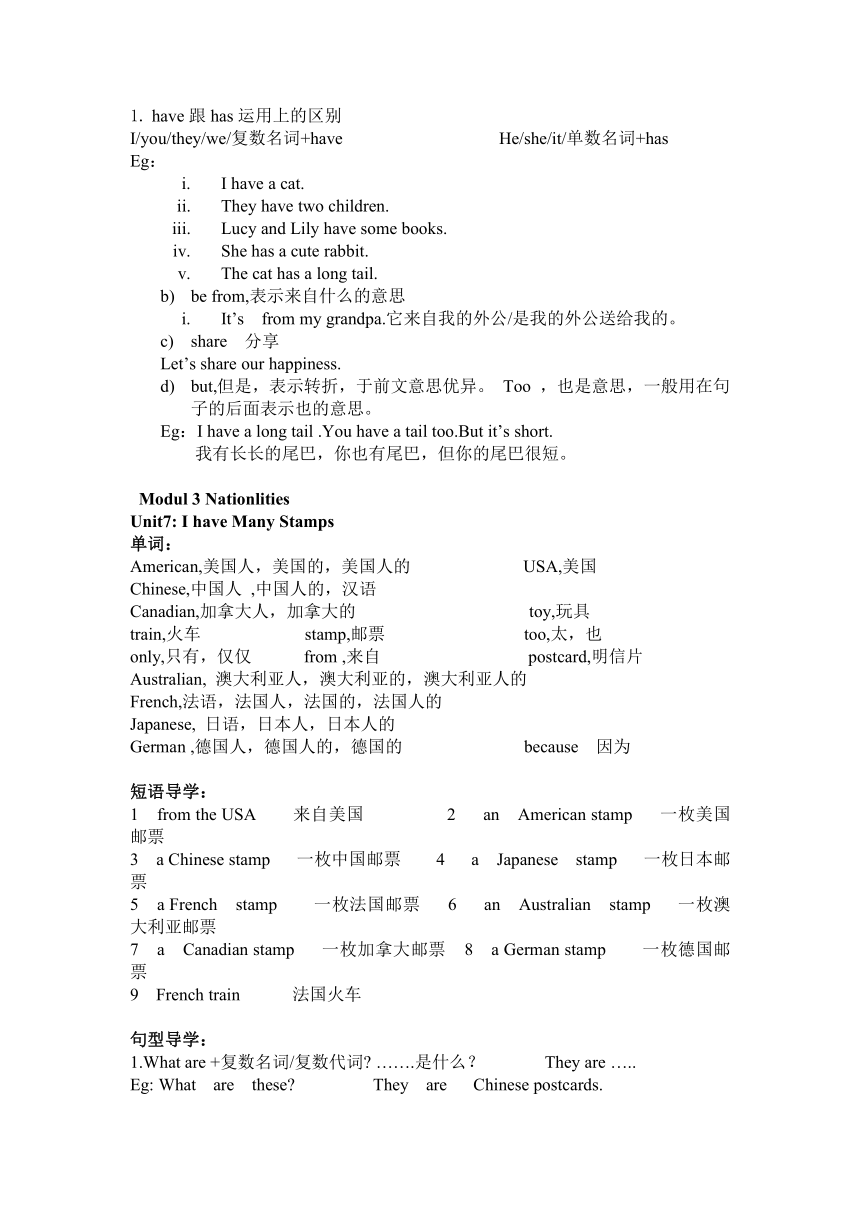
文档简介
2012广州版小学三年级下册期末总复习
Modul 1 Relationship
Unit1: Look at my family tree
单词:
Tree 树 father 父亲 mother母亲
Grandmother 奶奶 grandfather爷爷 daughter女儿
brother兄弟 sister姐妹 aunt姨,舅妈
uncle叔叔 son儿子 cousin堂兄弟姐妹,表兄弟姐妹 who谁 she她, her她的
he他 their他们的 tall高的
his他的 she’s =she is她是 he’s = he is他是
who’s=who is是谁 who谁 right对的
so那么, child小孩,孩子 children孩子们
have有, family tree 家谱, husband,丈夫
wife妻子
短语:
1.family tree家谱 2.my mother’s brother 我的母亲的兄弟
3.three children 三个小孩 4.their children 他们的孩子
5.his wife 他的妻子 6.your grandmother 你的奶奶
7.my grandfather’s son 我的奶奶的儿子 8.her husband 她的丈夫
句型导学:
what’s… 特殊疑问句,问什么?
Eg: What’s that It’s my family tree.
who’s… 特殊疑问句,问一个人物的提问(谁,单数)?Eg :
①Who’s Betty Webb She’s my grandmother.
②Who’s he/she/the man/the boy/the woman/the lady/the girl
He’s/She’s+姓名/称呼.
3. Is he/she/人物名称… 一般疑问句,问某人是不是….
回答:Yes,he/she is. No,he/she isn’t.
4.have的用法,
have,有的意思,只用在主语是复数(they,we,you,two men、three women)和I,you之后。eg : ①They have three children. ②I have three apples.
③Do you have a cat Yes,I do. No,I don’t.
④My father and mother have two children.
5.and的用法 and,表示和的意思,表示前后两个事物,
①放在句子前面作主语时,be动词用复数are。
Eg:David and Linda are my friends.
②放在句子中间动词后面
Eg:Mary and you are sister and brother.
Unit 2: Who Are They
单词:
old 老的 small,小的 beautiful,漂亮的
pretty,漂亮的美丽的 tall,高的 short,矮的
strong,强壮的 long,长的 cute,逗人喜欢的
boy,男孩 girl,女孩 bady婴儿
women,妇女 man,男人 about,关于
with有,和……在一起……what about…怎么样 those,那些
her,她的 look at,看 lady,女士
lim,苗条的
短语导学:
1.My aunt Jane 我的Jane阿姨 2.a beautiful women 一个漂亮的女人
3.a tall man 一个高大的男人 4.uncle Sam’s son Sam叔叔的儿子
5.a cute baby 一个可爱的婴儿 6.an old man 一个老人
7.a short woman 一个小个子妇女 8. very pretty 十分漂亮
9.a lady with grey hair 长着灰色头发的女士
10.look at that cute baby 看看那位可爱的婴儿
句型导学:
1. who is/are… 特殊疑问句,对人物是谁的提问。
①who’s… 对某一人物(单数)是什么人的提问。
Who is the man/boylady/girl/women He/she’s….
②who are+名词复数或复数代词… 对某些人物(复数)是什么人的提问。
Eg:Who are the children They are Mary and Tom.
Who are they They are…
2 .Is it … 一般疑问句,它是不是……
Eg: Is it your bag? Yes,it is . No,it isn’t.
with的用法
with, 表示①有,②和……在一起……的意思
The girl with long hair is my sister. 那个有一头长发的女孩是我的妹妹。
Come here and sit with me .过来跟我一起坐。
what about… 的用法。
What about… ......怎么样?是对于前面问题的一个省略的提问,跟前一个问题是一样的
Eg:A:Who is the girl in white B:She is my sister.
A:What about the tall man =(who is the tall man ) B:He is my cousin.
Unit 3 Let’s go further
句型导学:
My name is+人物的姓名….我的名字是…… Eg: My name is XiaoMing.
Modul 2 Animals
Unit 4:We like Your farm
单词:
any一些 pig, 猪 some,一些,有些
cow,奶牛 duck,鸭子 goose,鹅
geese,鹅(复数) chicken,鸡 goat山羊,
sheep,绵羊 horse马, dog,狗
cat,猫 farm,农场 do,助动词
don’t=do not 不, have,有 has,有(单数)
like,喜欢 big,大的 Here they are. 在这儿
bull,公牛 wow,哇 horn,角
短语:
1.very pretty 非常美丽 2.look at 看
句型导学:
1.What’s this/that 对事物单数这、那是什么的提问。
回答:It’s….
Eg:What’s this It’s my cat.
2.have跟has运用上的区别
I/you/they/we/复数名词+have He/she/it/单数名词+has
Eg: ①I have a cat. ②They have two children.
Lucy and Lily have some books. ④She has a cute rabbit.
The cat has a long tail.
3.some 和any 的区别和用法
some 和any都表示有一些,某一些的意思,后面接的一般是名词复数,但用法上有区别,some一般用在肯定句,而any一般用在疑问句和否定句中,但在疑问句中,想得到别人肯定回答的或真的很希望别人答应的就用some。
Eg:
I have some pets.
Do you have any pets
Yes,I do.I have a dog and a rabbit. No,I don’t have any pets
Do you want to have some drink
4.Do you have… 你有没有什么? Yes,I do. No,I don’t.
Eg:---Do you have a pen ---Yes,I do. No,I don’t.
5.Does he/she/it 名词单数… 助动词do在主语是单数的时候要用单数形式,回答的时候也要主意主语和谓语一致。
Eg:①---Does he have a borther ---Yes,he does. No,he doesn’t.
②--- Does Lily have a rabbit --- Yes,she does. No,she doesn’t.
6. what about… 的用法。
What about… ......怎么样?是对于前面问题的一个省略的提问,跟前一个问题是一样的
Eg:A:Who is the girl in white B:She is my sister.
A:What about the tall man =(who is the tall man ) B:He is my cousin.
Unit 5:I have cute pets
单词:
rabbit, 兔子 mouse ,老鼠 mice,老鼠(复数)
small,小的 big,大的 pet,宠物
tail,尾巴 fish, 鱼 don’t=do not,不
but ,但是 frog,青蛙 turtle,乌龟
guinea pig,豚鼠 goldfish,金鱼
短语导学:
1.a turtle and a frog 一只乌龟和一只青蛙 2.four legs 四条腿
3.a short tail 一条尾巴 4.a big mouth 一张大嘴巴
句型导学:
1.Do you have… 你有没有什么? Yes,I do. No,I don’t.
Eg:---Do you have a pen ---Yes,I do. No,I don’t.
2.have跟has运用上的区别 I/you/they/we/复数名词+have
He/she/it/单数名词+has
Eg: ①I have a cat. ② They have two children.
③Lucy and Lily have some books.
④She has a cute rabbit. ⑤The cat has a long tail.
3. a是不定冠词,表示一(个,支,本,块……)的意思,用在辅音素开头的单数名词前,如:a pencil(一支铅笔),a book(一本书);如:
a clock 一座钟 a book 一本书
名词复数的变化规则
英语名词分为可数名词和不可数名词。其中,可数名词超过一个时,必须用复数形式。一下是名词复数的变化规则:
1.一般名词复数是在名词后面加上“s”,如map→maps, bag→bags等;
2.以s,sh,ch,x等结尾的词加“es”,如bus→buses, watch→watches等;
3.以辅音字母+y结尾的词,变y为i加es,如baby→babies等;以元音字母+ y结尾的名词变复数时,直接加s变复数,如monkey→monkeys, holiday→holidays, storey→storeys(楼层);
4.以o 结尾的名词变复数时:
a)加s的名词有:photo→photos ,piano→pianos, radio→radios, zoo→zoos
b)加es的名词有:
potato→potatoes tomato→tomatoes
5.以f或fe结尾的名词变复数时:
a)加s的名词有: belief→beliefs roof→roofs safe→safes gulf→gulfs
b)去掉f, fe 加ves的名词有:
half→halves knife→knives leaf→leaves wolf→wolves
wife→wives life→lives thief→thieves
Unit 6 Let’s go further
句型导学:
1. have跟has运用上的区别
I/you/they/we/复数名词+have He/she/it/单数名词+has
Eg:
I have a cat.
They have two children.
Lucy and Lily have some books.
She has a cute rabbit.
The cat has a long tail.
be from,表示来自什么的意思
It’s from my grandpa.它来自我的外公/是我的外公送给我的。
share 分享
Let’s share our happiness.
but,但是,表示转折,于前文意思优异。 Too ,也是意思,一般用在句子的后面表示也的意思。
Eg:I have a long tail .You have a tail too.But it’s short.
我有长长的尾巴,你也有尾巴,但你的尾巴很短。
Modul 3 Nationlities
Unit7: I have Many Stamps
单词:
American,美国人,美国的,美国人的 USA,美国
Chinese,中国人 ,中国人的,汉语
Canadian,加拿大人,加拿大的 toy,玩具
train,火车 stamp,邮票 too,太,也
only,只有,仅仅 from ,来自 postcard,明信片
Australian, 澳大利亚人,澳大利亚的,澳大利亚人的
French,法语,法国人,法国的,法国人的
Japanese, 日语,日本人,日本人的
German ,德国人,德国人的,德国的 because 因为
短语导学:
1 from the USA 来自美国 2 an American stamp 一枚美国邮票
3 a Chinese stamp 一枚中国邮票 4 a Japanese stamp 一枚日本邮票
5 a French stamp 一枚法国邮票 6 an Australian stamp 一枚澳大利亚邮票
7 a Canadian stamp 一枚加拿大邮票 8 a German stamp 一枚德国邮票
9 French train 法国火车
句型导学:
1.What are +复数名词/复数代词 …….是什么? They are …..
Eg: What are these They are Chinese postcards.
2. Are they +名词复数?一般疑问句,是不是……
Eg:Are they Canadian stamps Yes,they are. No,they aren’t.
3.Are these/those+名词复数… 一般疑问句,这些/那些是不是……
Yes, they are. No,they aren’t.
Eg:Are these you books? Yes, they are. No,they aren’t.
4.Is this/that+名词单数… 一半 疑问句, 这/那是不是……
Yes, it is. No,it isn’t.
Eg:Is this your bag?
Yes, it is. No,it isn’t.
5. be from,表示来自的意思,本文表示来自什么国家。
Eg:It’ s a postcard from the USA.它是一张来自美国的明信片。
6.Do you have… 你是否有…… Yes,I do. No,I don’t.
Eg: Do you have any stamps Yes,I do. No,I don’t.
7. any表示有一些,某一些的意思,后面接的一般是名词复数, any一般用在疑问句和否定句中, Eg:
Do you have any pets Yes,I do.I have a dog and a rabbit.
No,I don’t have any pets
Unit 8: Where Are They From
单词:
China, 中国 PRC,中华人民共和国
UK,英国,联合英国 Britain,大不列颠,英国
toy玩具 we 我们 we’re=we are,我们是
both , 两者都 all,全部的 Canada,加拿大
Japan,日本 Germany,德国 France,法兰西,法国
Australia,澳大利亚 guess猜
短语导学:
from Janpan/China/Germany/Britain 来自日本、中国、德国、英国
句型导学:
1.Where be (is、are)+人称 from 问别人来自哪里,一般是对国籍的提问。回答为…be from +国籍。
Eg:①Where are you from
I am from Japan,I’m Japanese.
②Where is he/the man/boy/she/the woman/girl from
He/she is from China.
2.Be+某人+ from +国籍?一般疑问句,……是不是来自某个国家?
Eg:①Are you China
Yes,I am. No,I’m not.
②Is he from Canada
Yes,he is. No,he isn’t..
3.Do you have… 你是否有…… Yes,I do. No,I don’t.
Eg: Do you have any stamps
Yes,I do. No,I don’t.
Unit 9 Let’s go further
句型导学:
welcome to …欢迎。。。。。。 eg:Welcome to our school.
be from,表示来自的意思,本文表示来自什么国家。
Eg: I am koto from Australia.
pleaed to…很高兴….
Eg:Pleaed to meet you .
Modul 4 My Room
Unit 10: It Is My Bedroom
单词:
room, 房间 Bedroom,卧室 wall,墙壁
door,门 window,窗户 stool,凳子
draw,画 picture,图片 of course,当然
ceiling,天花板 wardrobe,衣柜 ha-ha,哈哈
短语导学:
in the bedroom 在卧室 2 tow bedrooms 两间卧室
3 on the table 在桌子上 4 draw an apple 画一个苹果
句型导学:
1.Draw your bedroom! 祈使句 OK!
2.Where be+名词/代词 ….在哪里?对事物所在位置的提问,
回答: It is/they are on/in/under/beside/behind/at/by….
Eg:①Where is the book It is on the table.
②Where are the apples They are in the fridge.
3.What be +代词(this/that/these/those) ……是什么? 回答: It is/they are ….
Eg:①What is that It’s a dog.
What are these They are China stamps.
4.Do you have… 你是否有…… Yes,I do. No,I don’t.
Eg: Do you have a stool in your bedroom Yes,I do. No,I don’t.
Unit 11:Put The Table against The wall
单词:
map, 地图 lamp,台灯 TV,电视
clock,闹钟 by,在…..旁边 under,在……下面
in front of,在……前面 behind,在 后面
there’s=there is,有 there are,有 put,放
which, 哪一个 them, 他们 draw,画
shelf,架子 sofa,沙发 shelves,架子(复数)
against,靠着 idea,主意 Good idea! 好主意
Spider ,蜘蛛 corner,角落
短语导学:
against the wall 挨着墙 2.in the corner 在墙角
3.on the foor 在地板上 4.on the shelf 在架子上
5.under the bed 在床底下 6.on the ceiling 在天花板上
句型导学:
Put the books on the desk. 祈使句 :动词放在句子前面。 回答: All right./ OK.
Eg:①Put the bed by the window. OK.
②Put the books on the shelf. All right.
Which one The one beside the wall.
Let’s put the chair against the shelf. OK!
which,哪一个,两者以上中的一个,特殊疑问词。
Eg:Which book do you want The red one.
3.Where be+名词/代词 ….在哪里?对事物所在位置的提问,
回答: It is/they are on/in/under/beside/behind/at/by….
Eg:①Where is the book It is on the table.
②Where are the shelves They are on the floor/.On the floor.
There be句型主要用以表达“某处(某时)有某人(某物)。”
其基本结构为“There be+某物(某人)+某地(某时)”其中there是引导词,没有词义;主语是be后面的名词, be是谓语动词,在一般现在时中be只用is和are两种形式。下面这首歌诀可帮你巧记there be句型结构:
(1)There be放句首,主语跟在后。地、时放句末,强调置前头。如:
There is a book on the desk.
有时为了强调地点,也可把介词短语放在句首。如:
On the desk there is a book.
(2)There be句型中的be动词如何确定呢?请先看看下面这首歌诀:
Be动词,有三个,am,is还有are。“There be”真特别,不留am只留俩,那就是is还有are。要用is还是are,须看其后的名词是单数还是复数。若是单数或不可数名词用is,否则就用are。如:
①There is a tree behind the house.
②There is some water(水)in the bottle(瓶子).
③There are some pears in the box.
(3)注意:如果“be”后的主语是由and连接的两个或两个以上的名词,那么be的形式要遵循“远亲不如近邻”的原则。也就是说,“be”的形式是由与它最近的那个名词来确定的。若那个名词是单数或不可数名词要用is,是复数就用are。如:
①There is a book and some pens on the floor.
②There are some pens and a book on the floor.
Unit 12 Let’go further
句型导学:
1.Where be+名词/代词 ….在哪里?对事物所在位置的提问,
回答: It is/they are on/in/under/beside/behind/at/by….
Eg:①Where is the book It is on the table.
②Where are the shelves They are on the floor/.On the floo
2.There be句型主要用以表达“某处(某时)有某人(某物)。”
其基本结构为“There be+某物(某人)+某地(某时)”其中there是引导词,没有词义;主语是be后面的名词, be是谓语动词,在一般现在时中be只用is和are两种形式。下面这首歌诀可帮你巧记there be句型结构:
(1)There be放句首,主语跟在后。地、时放句末,强调置前头。如:
There is a book on the desk.
有时为了强调地点,也可把介词短语放在句首。如:
On the desk there is a book.
(2)There be句型中的be动词如何确定呢?请先看看下面这首歌诀:
Be动词,有三个,am,is还有are。“There be”真特别,不留am只留俩,那就是is还有are。要用is还是are,须看其后的名词是单数还是复数。若是单数或不可数名词用is,否则就用are。如:
①There is a tree behind the house.
②There is some water(水)in the bottle(瓶子).
③There are some pears in the box.
(3)注意:如果“be”后的主语是由and连接的两个或两个以上的名词,那么be的形式要遵循“远亲不如近邻”的原则。也就是说,“be”的形式是由与它最近的那个名词来确定的。若那个名词是单数或不可数名词要用is,是复数就用are。如:
①There is a book and some pens on the floor.
②There are some pens and a book on the floor.
Modul 5 My home
Unit 13: Come in !
单词:
house,房子 glass, 玻璃 kitchen厨房,
come,来 watch,看 sit,坐
come in ,进来 cookie,曲奇饼 cupboard,碗柜
juice,果汁 welcome,欢迎
You’re welcome!不客气 Opps ,哎呀 tissue 纸巾
短语导学:
watch TV 看电视 2 in the living room 在客厅
3 sit with me 跟我坐在一起 4 on the sofa 在沙发
5 on the table 在桌子上 6 in the cupboard 在碗柜里
7 in the kitchen 在厨房里 8 Here’s you juice. 给你果汁。
9 Come in。进来。 10 sit with me 跟我一起坐
句型导学
1. with的用法 with,表示①有,②和……在一起……的意思
The girl with long hair is my sister. 那个有一头长发的女孩是我的妹妹。
Come here and sit with me .过来跟我一起坐。
Be there… 有没有…… Eg:①Is there a book on the desk
Yes,there is. No,there isn’t.
②Are there any cookies in the fridge Yes,there are. No,ther aren’t.
some 和any 的区别和用法
some 和any都表示有一些,某一些的意思,后面接的一般是名词复数,但用法上有区别,some一般用在肯定句,而any一般用在疑问句和否定句中,但在疑问句中,想得到别人肯定回答的或真的很希望别人答应的就用some。
Eg: ① I have some pets. ② Do you have any pets
Yes,I do.I have a dog and a rabbit. No,I don’t have any pets
③ Do you want to have some drink Yes,thank you.
Thank you ! 谢谢你! 4 You’re welcome! 不客气。 5 here be…,表示给的意思
eg:Here’s the tissue. Thank you !
Unit 14: This Is My House In England
单词:
Living room,客厅 England,英格兰 bathroom,浴室
computer,电脑 study,书房 lovely,可爱的
have a look 看一看 garden, 花园 garage,车房
upstairs,楼上 downstairs,楼下 fridge,电冰箱
messy, 杂乱的
短语导学:
1 in England 在英国 2 in the fridge 在冰箱里
3 come and have a look来看一看 4 all the bedrooms 所有的卧室
5 in the study 在书房里 6 a lovely house 一间可爱的房子
句型导学:
1. Be there… 有没有……
Eg:①Is there a book on the desk Yes,there is. No,there isn’t.
②Are there any cookies in the fridge Yes,there are. No,ther aren’t.
2.Let’s open the fridge.祈使句,让我们打开冰箱。 All right.
3. some 和any 的区别和用法
some 和any都表示有一些,某一些的意思,后面接的一般是名词复数,但用法上有区别,some一般用在肯定句,而any一般用在疑问句和否定句中,但在疑问句中,想得到别人肯定回答的或真的很希望别人答应的就用some。 Eg:
I have some pets.
Do you have any pets
Yes,I do.I have a dog and a rabbit. No,I don’t have any pets
Do you want to have some drink Yes,thank you.
Unit 15 Let’s go further
句型导学:
1 whose… 谁的? Eg:①Whose bed is this It’s my bed.
②Whose shoes are these They are very nice. They are Lily’s.
2. Where be+名词/代词 ….在哪里?对事物所在位置的提问,
回答: It is/they are on/in/under/beside/behind/at/by….
Eg:①Where is the book It is on the table.
②Where are the shelves They are on the floor/.On the floor
Modul 6 My school
Unit 16: Clean The Classroom
单词:
classroom,课室 between,在…..两者中间 backboard, 黑板
exercise,练习 clean,清洁 near 在…..附近
little, 小的 exercise book,练习书 board, 板
board rubber,黑板擦 tape recorder,录音机 chalk,粉笔
dictionary字典
短语导学:
clean the classroom 打扫教室
under the desk 在桌子下面
in Miss White’s desk 在White老师桌子里
in that coener 在那个角落
on the shelf 在架子上
beside the exercise book 在作业本旁
between the dictionary and the tape recorder 在字典和录音机之间
句型导学:
1.Where be+名词/代词 ….在哪里?对事物所在位置的提问,
回答: It is/they are on/in/under/beside/behind/at/by….
Eg:①Where is the book
It is on the table.
②Where are the shelves They are on the floor/.On the floo
③Where is the board rubber It is on the teacher’s desk.
Let’s clean the classroom. All right.
Put the exercise book on the desk. All right,
Unit 17: Visit Our School.
单词:
school,学校 building,大楼 office,办公室
toilet,厕所 gate,大门 our,我们的
teachers’ room,老师办公室 visit,参观
swimming pool,游泳池 playground,操场 flowerbed,花坛
library,图书馆 clinic,诊所 canteen,餐厅
statue 雕塑,雕像 opposite,在……对面
headmaster,校长 hungry. 饥饿的
短语导学:
in the building 在大楼里面
school building 教学楼
headmaster’s office 校长办公室
in the school 在学校
in the classroom 在课室里
between the book and the cat 在书和猫之间
near our classroom 在我们教室附近
句型导学:
1. Where be+名词/代词 ….在哪里?对事物所在位置的提问,
回答: It is/they are on/in/under/beside/behind/at/by….
Eg:①Where is the book
It is on the table.
②Where are the shelves They are on the floor/.On the floo
③Where’s the library It’s in the school building.
2.How many +可数名词复数+are there?How many +不可数名词+is there?问数量的特殊疑问句。
Eg:①How many classrooms are there in your school
There are sixteen./Sixteen/16.
②How many juiceis there in the glass
There is a little.
be opposite to 在……的对面
eg:The library is opposite to the teachers’room.
between…and…在什么和什么之间
eg:It’s between the teachers’ room and the clinic.
5. There be句型主要用以表达“某处(某时)有某人(某物)。”
其基本结构为“There be+某物(某人)+某地(某时)”其中there是引导词,没有词义;主语是be后面的名词, be是谓语动词,在一般现在时中be只用is和are两种形式。
Eg:①There are some toilets near our classroom.
②There is a boy under the tree.
be hungry 感到饥饿
eg:I’m hungry.
Modul 1 Relationship
Unit1: Look at my family tree
单词:
Tree 树 father 父亲 mother母亲
Grandmother 奶奶 grandfather爷爷 daughter女儿
brother兄弟 sister姐妹 aunt姨,舅妈
uncle叔叔 son儿子 cousin堂兄弟姐妹,表兄弟姐妹 who谁 she她, her她的
he他 their他们的 tall高的
his他的 she’s =she is她是 he’s = he is他是
who’s=who is是谁 who谁 right对的
so那么, child小孩,孩子 children孩子们
have有, family tree 家谱, husband,丈夫
wife妻子
短语:
1.family tree家谱 2.my mother’s brother 我的母亲的兄弟
3.three children 三个小孩 4.their children 他们的孩子
5.his wife 他的妻子 6.your grandmother 你的奶奶
7.my grandfather’s son 我的奶奶的儿子 8.her husband 她的丈夫
句型导学:
what’s… 特殊疑问句,问什么?
Eg: What’s that It’s my family tree.
who’s… 特殊疑问句,问一个人物的提问(谁,单数)?Eg :
①Who’s Betty Webb She’s my grandmother.
②Who’s he/she/the man/the boy/the woman/the lady/the girl
He’s/She’s+姓名/称呼.
3. Is he/she/人物名称… 一般疑问句,问某人是不是….
回答:Yes,he/she is. No,he/she isn’t.
4.have的用法,
have,有的意思,只用在主语是复数(they,we,you,two men、three women)和I,you之后。eg : ①They have three children. ②I have three apples.
③Do you have a cat Yes,I do. No,I don’t.
④My father and mother have two children.
5.and的用法 and,表示和的意思,表示前后两个事物,
①放在句子前面作主语时,be动词用复数are。
Eg:David and Linda are my friends.
②放在句子中间动词后面
Eg:Mary and you are sister and brother.
Unit 2: Who Are They
单词:
old 老的 small,小的 beautiful,漂亮的
pretty,漂亮的美丽的 tall,高的 short,矮的
strong,强壮的 long,长的 cute,逗人喜欢的
boy,男孩 girl,女孩 bady婴儿
women,妇女 man,男人 about,关于
with有,和……在一起……what about…怎么样 those,那些
her,她的 look at,看 lady,女士
lim,苗条的
短语导学:
1.My aunt Jane 我的Jane阿姨 2.a beautiful women 一个漂亮的女人
3.a tall man 一个高大的男人 4.uncle Sam’s son Sam叔叔的儿子
5.a cute baby 一个可爱的婴儿 6.an old man 一个老人
7.a short woman 一个小个子妇女 8. very pretty 十分漂亮
9.a lady with grey hair 长着灰色头发的女士
10.look at that cute baby 看看那位可爱的婴儿
句型导学:
1. who is/are… 特殊疑问句,对人物是谁的提问。
①who’s… 对某一人物(单数)是什么人的提问。
Who is the man/boylady/girl/women He/she’s….
②who are+名词复数或复数代词… 对某些人物(复数)是什么人的提问。
Eg:Who are the children They are Mary and Tom.
Who are they They are…
2 .Is it … 一般疑问句,它是不是……
Eg: Is it your bag? Yes,it is . No,it isn’t.
with的用法
with, 表示①有,②和……在一起……的意思
The girl with long hair is my sister. 那个有一头长发的女孩是我的妹妹。
Come here and sit with me .过来跟我一起坐。
what about… 的用法。
What about… ......怎么样?是对于前面问题的一个省略的提问,跟前一个问题是一样的
Eg:A:Who is the girl in white B:She is my sister.
A:What about the tall man =(who is the tall man ) B:He is my cousin.
Unit 3 Let’s go further
句型导学:
My name is+人物的姓名….我的名字是…… Eg: My name is XiaoMing.
Modul 2 Animals
Unit 4:We like Your farm
单词:
any一些 pig, 猪 some,一些,有些
cow,奶牛 duck,鸭子 goose,鹅
geese,鹅(复数) chicken,鸡 goat山羊,
sheep,绵羊 horse马, dog,狗
cat,猫 farm,农场 do,助动词
don’t=do not 不, have,有 has,有(单数)
like,喜欢 big,大的 Here they are. 在这儿
bull,公牛 wow,哇 horn,角
短语:
1.very pretty 非常美丽 2.look at 看
句型导学:
1.What’s this/that 对事物单数这、那是什么的提问。
回答:It’s….
Eg:What’s this It’s my cat.
2.have跟has运用上的区别
I/you/they/we/复数名词+have He/she/it/单数名词+has
Eg: ①I have a cat. ②They have two children.
Lucy and Lily have some books. ④She has a cute rabbit.
The cat has a long tail.
3.some 和any 的区别和用法
some 和any都表示有一些,某一些的意思,后面接的一般是名词复数,但用法上有区别,some一般用在肯定句,而any一般用在疑问句和否定句中,但在疑问句中,想得到别人肯定回答的或真的很希望别人答应的就用some。
Eg:
I have some pets.
Do you have any pets
Yes,I do.I have a dog and a rabbit. No,I don’t have any pets
Do you want to have some drink
4.Do you have… 你有没有什么? Yes,I do. No,I don’t.
Eg:---Do you have a pen ---Yes,I do. No,I don’t.
5.Does he/she/it 名词单数… 助动词do在主语是单数的时候要用单数形式,回答的时候也要主意主语和谓语一致。
Eg:①---Does he have a borther ---Yes,he does. No,he doesn’t.
②--- Does Lily have a rabbit --- Yes,she does. No,she doesn’t.
6. what about… 的用法。
What about… ......怎么样?是对于前面问题的一个省略的提问,跟前一个问题是一样的
Eg:A:Who is the girl in white B:She is my sister.
A:What about the tall man =(who is the tall man ) B:He is my cousin.
Unit 5:I have cute pets
单词:
rabbit, 兔子 mouse ,老鼠 mice,老鼠(复数)
small,小的 big,大的 pet,宠物
tail,尾巴 fish, 鱼 don’t=do not,不
but ,但是 frog,青蛙 turtle,乌龟
guinea pig,豚鼠 goldfish,金鱼
短语导学:
1.a turtle and a frog 一只乌龟和一只青蛙 2.four legs 四条腿
3.a short tail 一条尾巴 4.a big mouth 一张大嘴巴
句型导学:
1.Do you have… 你有没有什么? Yes,I do. No,I don’t.
Eg:---Do you have a pen ---Yes,I do. No,I don’t.
2.have跟has运用上的区别 I/you/they/we/复数名词+have
He/she/it/单数名词+has
Eg: ①I have a cat. ② They have two children.
③Lucy and Lily have some books.
④She has a cute rabbit. ⑤The cat has a long tail.
3. a是不定冠词,表示一(个,支,本,块……)的意思,用在辅音素开头的单数名词前,如:a pencil(一支铅笔),a book(一本书);如:
a clock 一座钟 a book 一本书
名词复数的变化规则
英语名词分为可数名词和不可数名词。其中,可数名词超过一个时,必须用复数形式。一下是名词复数的变化规则:
1.一般名词复数是在名词后面加上“s”,如map→maps, bag→bags等;
2.以s,sh,ch,x等结尾的词加“es”,如bus→buses, watch→watches等;
3.以辅音字母+y结尾的词,变y为i加es,如baby→babies等;以元音字母+ y结尾的名词变复数时,直接加s变复数,如monkey→monkeys, holiday→holidays, storey→storeys(楼层);
4.以o 结尾的名词变复数时:
a)加s的名词有:photo→photos ,piano→pianos, radio→radios, zoo→zoos
b)加es的名词有:
potato→potatoes tomato→tomatoes
5.以f或fe结尾的名词变复数时:
a)加s的名词有: belief→beliefs roof→roofs safe→safes gulf→gulfs
b)去掉f, fe 加ves的名词有:
half→halves knife→knives leaf→leaves wolf→wolves
wife→wives life→lives thief→thieves
Unit 6 Let’s go further
句型导学:
1. have跟has运用上的区别
I/you/they/we/复数名词+have He/she/it/单数名词+has
Eg:
I have a cat.
They have two children.
Lucy and Lily have some books.
She has a cute rabbit.
The cat has a long tail.
be from,表示来自什么的意思
It’s from my grandpa.它来自我的外公/是我的外公送给我的。
share 分享
Let’s share our happiness.
but,但是,表示转折,于前文意思优异。 Too ,也是意思,一般用在句子的后面表示也的意思。
Eg:I have a long tail .You have a tail too.But it’s short.
我有长长的尾巴,你也有尾巴,但你的尾巴很短。
Modul 3 Nationlities
Unit7: I have Many Stamps
单词:
American,美国人,美国的,美国人的 USA,美国
Chinese,中国人 ,中国人的,汉语
Canadian,加拿大人,加拿大的 toy,玩具
train,火车 stamp,邮票 too,太,也
only,只有,仅仅 from ,来自 postcard,明信片
Australian, 澳大利亚人,澳大利亚的,澳大利亚人的
French,法语,法国人,法国的,法国人的
Japanese, 日语,日本人,日本人的
German ,德国人,德国人的,德国的 because 因为
短语导学:
1 from the USA 来自美国 2 an American stamp 一枚美国邮票
3 a Chinese stamp 一枚中国邮票 4 a Japanese stamp 一枚日本邮票
5 a French stamp 一枚法国邮票 6 an Australian stamp 一枚澳大利亚邮票
7 a Canadian stamp 一枚加拿大邮票 8 a German stamp 一枚德国邮票
9 French train 法国火车
句型导学:
1.What are +复数名词/复数代词 …….是什么? They are …..
Eg: What are these They are Chinese postcards.
2. Are they +名词复数?一般疑问句,是不是……
Eg:Are they Canadian stamps Yes,they are. No,they aren’t.
3.Are these/those+名词复数… 一般疑问句,这些/那些是不是……
Yes, they are. No,they aren’t.
Eg:Are these you books? Yes, they are. No,they aren’t.
4.Is this/that+名词单数… 一半 疑问句, 这/那是不是……
Yes, it is. No,it isn’t.
Eg:Is this your bag?
Yes, it is. No,it isn’t.
5. be from,表示来自的意思,本文表示来自什么国家。
Eg:It’ s a postcard from the USA.它是一张来自美国的明信片。
6.Do you have… 你是否有…… Yes,I do. No,I don’t.
Eg: Do you have any stamps Yes,I do. No,I don’t.
7. any表示有一些,某一些的意思,后面接的一般是名词复数, any一般用在疑问句和否定句中, Eg:
Do you have any pets Yes,I do.I have a dog and a rabbit.
No,I don’t have any pets
Unit 8: Where Are They From
单词:
China, 中国 PRC,中华人民共和国
UK,英国,联合英国 Britain,大不列颠,英国
toy玩具 we 我们 we’re=we are,我们是
both , 两者都 all,全部的 Canada,加拿大
Japan,日本 Germany,德国 France,法兰西,法国
Australia,澳大利亚 guess猜
短语导学:
from Janpan/China/Germany/Britain 来自日本、中国、德国、英国
句型导学:
1.Where be (is、are)+人称 from 问别人来自哪里,一般是对国籍的提问。回答为…be from +国籍。
Eg:①Where are you from
I am from Japan,I’m Japanese.
②Where is he/the man/boy/she/the woman/girl from
He/she is from China.
2.Be+某人+ from +国籍?一般疑问句,……是不是来自某个国家?
Eg:①Are you China
Yes,I am. No,I’m not.
②Is he from Canada
Yes,he is. No,he isn’t..
3.Do you have… 你是否有…… Yes,I do. No,I don’t.
Eg: Do you have any stamps
Yes,I do. No,I don’t.
Unit 9 Let’s go further
句型导学:
welcome to …欢迎。。。。。。 eg:Welcome to our school.
be from,表示来自的意思,本文表示来自什么国家。
Eg: I am koto from Australia.
pleaed to…很高兴….
Eg:Pleaed to meet you .
Modul 4 My Room
Unit 10: It Is My Bedroom
单词:
room, 房间 Bedroom,卧室 wall,墙壁
door,门 window,窗户 stool,凳子
draw,画 picture,图片 of course,当然
ceiling,天花板 wardrobe,衣柜 ha-ha,哈哈
短语导学:
in the bedroom 在卧室 2 tow bedrooms 两间卧室
3 on the table 在桌子上 4 draw an apple 画一个苹果
句型导学:
1.Draw your bedroom! 祈使句 OK!
2.Where be+名词/代词 ….在哪里?对事物所在位置的提问,
回答: It is/they are on/in/under/beside/behind/at/by….
Eg:①Where is the book It is on the table.
②Where are the apples They are in the fridge.
3.What be +代词(this/that/these/those) ……是什么? 回答: It is/they are ….
Eg:①What is that It’s a dog.
What are these They are China stamps.
4.Do you have… 你是否有…… Yes,I do. No,I don’t.
Eg: Do you have a stool in your bedroom Yes,I do. No,I don’t.
Unit 11:Put The Table against The wall
单词:
map, 地图 lamp,台灯 TV,电视
clock,闹钟 by,在…..旁边 under,在……下面
in front of,在……前面 behind,在 后面
there’s=there is,有 there are,有 put,放
which, 哪一个 them, 他们 draw,画
shelf,架子 sofa,沙发 shelves,架子(复数)
against,靠着 idea,主意 Good idea! 好主意
Spider ,蜘蛛 corner,角落
短语导学:
against the wall 挨着墙 2.in the corner 在墙角
3.on the foor 在地板上 4.on the shelf 在架子上
5.under the bed 在床底下 6.on the ceiling 在天花板上
句型导学:
Put the books on the desk. 祈使句 :动词放在句子前面。 回答: All right./ OK.
Eg:①Put the bed by the window. OK.
②Put the books on the shelf. All right.
Which one The one beside the wall.
Let’s put the chair against the shelf. OK!
which,哪一个,两者以上中的一个,特殊疑问词。
Eg:Which book do you want The red one.
3.Where be+名词/代词 ….在哪里?对事物所在位置的提问,
回答: It is/they are on/in/under/beside/behind/at/by….
Eg:①Where is the book It is on the table.
②Where are the shelves They are on the floor/.On the floor.
There be句型主要用以表达“某处(某时)有某人(某物)。”
其基本结构为“There be+某物(某人)+某地(某时)”其中there是引导词,没有词义;主语是be后面的名词, be是谓语动词,在一般现在时中be只用is和are两种形式。下面这首歌诀可帮你巧记there be句型结构:
(1)There be放句首,主语跟在后。地、时放句末,强调置前头。如:
There is a book on the desk.
有时为了强调地点,也可把介词短语放在句首。如:
On the desk there is a book.
(2)There be句型中的be动词如何确定呢?请先看看下面这首歌诀:
Be动词,有三个,am,is还有are。“There be”真特别,不留am只留俩,那就是is还有are。要用is还是are,须看其后的名词是单数还是复数。若是单数或不可数名词用is,否则就用are。如:
①There is a tree behind the house.
②There is some water(水)in the bottle(瓶子).
③There are some pears in the box.
(3)注意:如果“be”后的主语是由and连接的两个或两个以上的名词,那么be的形式要遵循“远亲不如近邻”的原则。也就是说,“be”的形式是由与它最近的那个名词来确定的。若那个名词是单数或不可数名词要用is,是复数就用are。如:
①There is a book and some pens on the floor.
②There are some pens and a book on the floor.
Unit 12 Let’go further
句型导学:
1.Where be+名词/代词 ….在哪里?对事物所在位置的提问,
回答: It is/they are on/in/under/beside/behind/at/by….
Eg:①Where is the book It is on the table.
②Where are the shelves They are on the floor/.On the floo
2.There be句型主要用以表达“某处(某时)有某人(某物)。”
其基本结构为“There be+某物(某人)+某地(某时)”其中there是引导词,没有词义;主语是be后面的名词, be是谓语动词,在一般现在时中be只用is和are两种形式。下面这首歌诀可帮你巧记there be句型结构:
(1)There be放句首,主语跟在后。地、时放句末,强调置前头。如:
There is a book on the desk.
有时为了强调地点,也可把介词短语放在句首。如:
On the desk there is a book.
(2)There be句型中的be动词如何确定呢?请先看看下面这首歌诀:
Be动词,有三个,am,is还有are。“There be”真特别,不留am只留俩,那就是is还有are。要用is还是are,须看其后的名词是单数还是复数。若是单数或不可数名词用is,否则就用are。如:
①There is a tree behind the house.
②There is some water(水)in the bottle(瓶子).
③There are some pears in the box.
(3)注意:如果“be”后的主语是由and连接的两个或两个以上的名词,那么be的形式要遵循“远亲不如近邻”的原则。也就是说,“be”的形式是由与它最近的那个名词来确定的。若那个名词是单数或不可数名词要用is,是复数就用are。如:
①There is a book and some pens on the floor.
②There are some pens and a book on the floor.
Modul 5 My home
Unit 13: Come in !
单词:
house,房子 glass, 玻璃 kitchen厨房,
come,来 watch,看 sit,坐
come in ,进来 cookie,曲奇饼 cupboard,碗柜
juice,果汁 welcome,欢迎
You’re welcome!不客气 Opps ,哎呀 tissue 纸巾
短语导学:
watch TV 看电视 2 in the living room 在客厅
3 sit with me 跟我坐在一起 4 on the sofa 在沙发
5 on the table 在桌子上 6 in the cupboard 在碗柜里
7 in the kitchen 在厨房里 8 Here’s you juice. 给你果汁。
9 Come in。进来。 10 sit with me 跟我一起坐
句型导学
1. with的用法 with,表示①有,②和……在一起……的意思
The girl with long hair is my sister. 那个有一头长发的女孩是我的妹妹。
Come here and sit with me .过来跟我一起坐。
Be there… 有没有…… Eg:①Is there a book on the desk
Yes,there is. No,there isn’t.
②Are there any cookies in the fridge Yes,there are. No,ther aren’t.
some 和any 的区别和用法
some 和any都表示有一些,某一些的意思,后面接的一般是名词复数,但用法上有区别,some一般用在肯定句,而any一般用在疑问句和否定句中,但在疑问句中,想得到别人肯定回答的或真的很希望别人答应的就用some。
Eg: ① I have some pets. ② Do you have any pets
Yes,I do.I have a dog and a rabbit. No,I don’t have any pets
③ Do you want to have some drink Yes,thank you.
Thank you ! 谢谢你! 4 You’re welcome! 不客气。 5 here be…,表示给的意思
eg:Here’s the tissue. Thank you !
Unit 14: This Is My House In England
单词:
Living room,客厅 England,英格兰 bathroom,浴室
computer,电脑 study,书房 lovely,可爱的
have a look 看一看 garden, 花园 garage,车房
upstairs,楼上 downstairs,楼下 fridge,电冰箱
messy, 杂乱的
短语导学:
1 in England 在英国 2 in the fridge 在冰箱里
3 come and have a look来看一看 4 all the bedrooms 所有的卧室
5 in the study 在书房里 6 a lovely house 一间可爱的房子
句型导学:
1. Be there… 有没有……
Eg:①Is there a book on the desk Yes,there is. No,there isn’t.
②Are there any cookies in the fridge Yes,there are. No,ther aren’t.
2.Let’s open the fridge.祈使句,让我们打开冰箱。 All right.
3. some 和any 的区别和用法
some 和any都表示有一些,某一些的意思,后面接的一般是名词复数,但用法上有区别,some一般用在肯定句,而any一般用在疑问句和否定句中,但在疑问句中,想得到别人肯定回答的或真的很希望别人答应的就用some。 Eg:
I have some pets.
Do you have any pets
Yes,I do.I have a dog and a rabbit. No,I don’t have any pets
Do you want to have some drink Yes,thank you.
Unit 15 Let’s go further
句型导学:
1 whose… 谁的? Eg:①Whose bed is this It’s my bed.
②Whose shoes are these They are very nice. They are Lily’s.
2. Where be+名词/代词 ….在哪里?对事物所在位置的提问,
回答: It is/they are on/in/under/beside/behind/at/by….
Eg:①Where is the book It is on the table.
②Where are the shelves They are on the floor/.On the floor
Modul 6 My school
Unit 16: Clean The Classroom
单词:
classroom,课室 between,在…..两者中间 backboard, 黑板
exercise,练习 clean,清洁 near 在…..附近
little, 小的 exercise book,练习书 board, 板
board rubber,黑板擦 tape recorder,录音机 chalk,粉笔
dictionary字典
短语导学:
clean the classroom 打扫教室
under the desk 在桌子下面
in Miss White’s desk 在White老师桌子里
in that coener 在那个角落
on the shelf 在架子上
beside the exercise book 在作业本旁
between the dictionary and the tape recorder 在字典和录音机之间
句型导学:
1.Where be+名词/代词 ….在哪里?对事物所在位置的提问,
回答: It is/they are on/in/under/beside/behind/at/by….
Eg:①Where is the book
It is on the table.
②Where are the shelves They are on the floor/.On the floo
③Where is the board rubber It is on the teacher’s desk.
Let’s clean the classroom. All right.
Put the exercise book on the desk. All right,
Unit 17: Visit Our School.
单词:
school,学校 building,大楼 office,办公室
toilet,厕所 gate,大门 our,我们的
teachers’ room,老师办公室 visit,参观
swimming pool,游泳池 playground,操场 flowerbed,花坛
library,图书馆 clinic,诊所 canteen,餐厅
statue 雕塑,雕像 opposite,在……对面
headmaster,校长 hungry. 饥饿的
短语导学:
in the building 在大楼里面
school building 教学楼
headmaster’s office 校长办公室
in the school 在学校
in the classroom 在课室里
between the book and the cat 在书和猫之间
near our classroom 在我们教室附近
句型导学:
1. Where be+名词/代词 ….在哪里?对事物所在位置的提问,
回答: It is/they are on/in/under/beside/behind/at/by….
Eg:①Where is the book
It is on the table.
②Where are the shelves They are on the floor/.On the floo
③Where’s the library It’s in the school building.
2.How many +可数名词复数+are there?How many +不可数名词+is there?问数量的特殊疑问句。
Eg:①How many classrooms are there in your school
There are sixteen./Sixteen/16.
②How many juiceis there in the glass
There is a little.
be opposite to 在……的对面
eg:The library is opposite to the teachers’room.
between…and…在什么和什么之间
eg:It’s between the teachers’ room and the clinic.
5. There be句型主要用以表达“某处(某时)有某人(某物)。”
其基本结构为“There be+某物(某人)+某地(某时)”其中there是引导词,没有词义;主语是be后面的名词, be是谓语动词,在一般现在时中be只用is和are两种形式。
Eg:①There are some toilets near our classroom.
②There is a boy under the tree.
be hungry 感到饥饿
eg:I’m hungry.
同课章节目录
- Module 1 Colours
- Unit 1 I like red
- Unit 2 Let's colour it
- Module 2 Positions
- Unit 3 Where's my car?
- Unit 4 Is it in your bag?
- Module 3 Personal information
- Unit 5 Happy birthday!
- Unit 6 May I have your telephone number?
- Module 4 Fruits
- Unit 7 May I have some grapes?
- Unit 8 Apple are good for us
- Module 5 Relatives
- Unit 9 Who is this cute baby?
- Unit 10 How many people are there in your family?
- Module 6 Pets
- Unit 11 They're lovely
- Unit 12 Whose rabbits are these?
- Module 7 Let's look back
